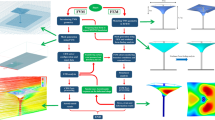Abstract
The use of bionic non-smooth surfaces is a popular approach for saving energy because of their drag reduction property. Conventional non-smooth structures include riblets and dimples. Inspired by sand dunes, a novel variable ovoid nonsmooth structure is proposed in this study. The body of the variable ovoid dimple was designed based on three size parameters, the radius, semimajor, and depth, and a 3D model was created based on UG software. The constructed variable dimples were placed in a rectangular array on the bottom of a square tube model. Following ANSYS meshing, the grid model was imported into FLUENT, where the flow characteristics were calculated. Results of skin friction reduction were achieved and the effect of the design parameters on different variable ovoid dimples was obtained by orthogonal testing. Various aspects of the skin friction reduction mechanism were discussed including the distribution of velocity vectors, variation in boundary layer thickness, and pressure distribution.
抽象
目 的
仿生非光滑表面具有降低表面摩擦阻力的作用, 传统的非光滑结构有沟槽和凹坑等。本文旨在研究变异卵圆形凹坑非光滑表面的气动摩擦减阻特性及其减阻机理。
创新点
1. 以仿生学理论为基础, 提出变异卵圆形凹坑结构模型, 突破现有非光滑结构类型的局限; 2. 采用参数构造的方法研究变异卵圆形各构造参数对表面摩擦阻力减阻的影响。
方 法
1. 采用半径、半轴和坑深3 个尺寸参数对变异卵圆凹坑结构进行几何定义, 并将非光滑结构以一定纵向间距按矩形排布布置在仿真模型底部; 2. 以3 个尺寸参数和纵向间距设计“三水平四因素”正交实验, 在不同气流流速下进行数值模拟仿真; 3. 通过速度矢量、边界层厚度变化和压力分布研究变异卵圆形凹坑非光滑表面的气动摩擦减阻机理。
结 论
1. 变异卵圆形非光滑表面具有一定的气动摩擦减阻效果, 和光滑表面相比, 在空气来流速度为24 m/s 时, 有10%的减阻效果; 2. 正交实验分析表明, 4 个试验因素对减阻效果的影响从大到小排列分别为: 半径、坑深、半轴和纵向间距; 3. 变异卵圆形凹坑表面增加了边界层的厚度, 降低了近壁面区域的速度梯度, 减少了剪切力, 从而起到了减少摩擦阻力的效果。
Similar content being viewed by others
References
Bixler, G.D., Bhushan, B., 2013. Shark skin inspired lowdrag microstructured surfaces in closed channel flow. Journal of Colloid and Interface Science, 393:384–396. http://dx.doi.org/10.1016/j.jcis.2012.10.061
Boiko, A.V., Jung, K.H., Chun, H.H., et al., 2007. Effect of riblets on the streaky structures excited by free stream tip vortices in boundary layer. Journal of Mechanical Science and Technology, 21(1):196–206. http://dx.doi.org/10.1007/BF03161725
Bourisli, R.I., Al-Sahhaf, A.A., 2008. CFD modeling of turbulent boundary layer flow in passive drag-reducing applications. 7th International Conference on Advances in Fluid Mechanics, p.79–90. http://dx.doi.org/10.2495/AFM080081
Bullen, R.D., McKenzie, N.L., 2008. The pelage of bats (Chiroptera) and the presence of aerodynamic riblets: the effect on aerodynamic cleanliness. Zoology, 111(4):279–286. http://dx.doi.org/10.1016/j.zool.2007.09.001
Choi, J., Jeon, W., Choi, H., 2006. Mechanism of drag reduction by dimples on a sphere. Physics of Fluids, 18(4): 041702. http://dx.doi.org/10.1063/1.2191848
Dean, B., Bhushan, B., 2010. Shark-skin surfaces for fluiddrag reduction in turbulent flow: a review. Advance in Mechanics, 368(1929):4775–4806. http://dx.doi.org/10.1098/rsta.2010.0201
Dean, B., Bhushan, B., 2012. The effect of riblets in rectangular duct flow. Applied Surface Science, 258(8):3936–3947. http://dx.doi.org/10.1016/j.apsusc.2011.12.067
Gao, G., Huang, N., 1982. Theoretical and experimental study in stability of the barchan dune vortex flame. Journal of Engineering Thermophysics, 3(1):89–95 (in Chinese).
Gu, Y.Q., Zhao, G., Liu, H., et al., 2013. Characteristics of drag reduction of bionic dimpled surface of shell rubber ring of aerodynamic extinguishing cannon. Journal of Jilin University (Engineering and Technology Edition), 43(4):983–990 (in Chinese).
Kim, J., Choi, H., 2014. Aerodynamics of a golf ball with grooves. Proceedings of the Institution of Mechanical Engineers, Part P: Journal of Sports Engineering and Technology, 228(4):233–241. http://dx.doi.org/10.1177/1754337114543860
Matthews, J.N.A., 2008. Low-drag suit propels swimmers. Physics Today, 61(8):32–33. http://dx.doi.org/10.1063/1.2970208
Ren, L.Q., 2009. Progress in the bionic study on antiadhesion and resistance reduction of terrain machines. Science in China Series E: Technological Sciences, 52(2):273–284. http://dx.doi.org/10.1007/s11431-009-0042-3
Song, X.W., Zhang, G.G., Wang, Y., et al., 2011. Use of bionic inspired surfaces for aerodynamic drag reduction on motor vehicle body panels. Journal of Zhejiang University-SCIENCE A (Applied Physics & Engineering), 12(7):543–551. http://dx.doi.org/10.1631/jzus.A1000505
Viswanath, P.R., 2002. Aircraft viscous drag reduction using riblets. Progress in Aerospace Sciences, 38(6-7):571–600. http://dx.doi.org/10.1016/S0376-0421(02)00048-9
Zhang, C.C., Ren, L.Q., Liu, Q.P., et al., 2008. Experimental study on bionic dimpled surfaces of bodies of revolution for drag reduction. Acta Aerodynamica Sinica, 26(1):79–84 (in Chinese). http://dx.doi.org/10.3969/j.issn.0258-1825.2008.01.015
Zhang, D.Y., Luo, Y.H., Li, X., et al., 2011. Numerical simulation and experimental study of drag-reducing surface of a real shark skin. Journal of Hydrodynamics, Ser. B, 23(2):204–211. http://dx.doi.org/10.1016/S1001-6058(10)60105-9
Author information
Authors and Affiliations
Corresponding author
Additional information
Project supported by the National Natural Science Foundation of China (No. 51375439)
ORCID: Xiao-wen SONG, http://orcid.org/0000-0001-6386-9836
Rights and permissions
About this article
Cite this article
Song, Xw., Lin, Pz., Liu, R. et al. Skin friction reduction characteristics of variable ovoid non-smooth surfaces. J. Zhejiang Univ. Sci. A 18, 59–66 (2017). https://doi.org/10.1631/jzus.A1500324
Received:
Accepted:
Published:
Issue Date:
DOI: https://doi.org/10.1631/jzus.A1500324




